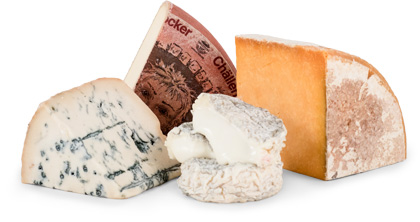Mimolette is a hard cow's milk cheese produced in Normandy, Brittany, Nord-Pas de Calais, and other parts of France. Some say it originated in Lille, France, while others think it was first made in Holland. We believe that Mimolette can be traced to the 17th century, specifically to the rule of King Louis XIV. His chief minister, Colbert, had banned the import of many foreign goods, such as Edam cheese. In Flanders, the northernmost region of France where the villagers had strong cultural ties to Holland, Edam was especially missed. Even today you will hear Dutch spoken as a first language in this part of France.
We often desire the forbidden, and Edam was smuggled into France against the King's decree. In time, the defiant French subjects began to make their own cheese from the same basic recipe. Of course, the French—being French—added a little panache. The artisans changed the shape and color. They flattened the top and bottom, and then added Roucou, a natural dye also known as annatto that provides a color ranging from cantaloupe or carrot to a bright deep tangerine.
Mimolette has been called a French Edam, although there are definite differences between the two. An important difference is the source of the milk. As you taste the cheese and compare it to Edam, you will see how diverse breeds of cows—and the grasses and herbs they feed on—alter the flavor. Intensely fruity and nutty, Mimolette is popular as a snack with a glass of beer. (Visit www.monthlyclubs.com to check out all of the incredibly tasty microbrews that you could enjoy with your cheeses.)
Mimolette is popular throughout France among cheese novices and connoisseurs alike. This is a good "starter cheese," and, if you are willing to part with it, is a good way to introduce cheese to the palates of your kids or some of your less cheese savvy friends whose idea of cheese is Velveeta. Mimolette is also called Boule de Lille; boule translates to ball, scoop or bowl, and the village of Lille is the location of the cellars where the cheese was first ripened. This delicious treat can be eaten young but, unlike Edam, Mimolette is usually matured for a minimum of six months. At that age it’s called a demi-étuvée or demi-vielle, meaning “half old.” The Mimolette you have received has matured for no less than twelve months!
In French, mi-mou means half soft and refers to the quite oily texture of this otherwise firm cheese. Aged Mimolette is often described as a sharp but mild cheese that is intensely fruity and nutty, with subtle notes of caramel. Except that it’s vibrant orange, Mimolette is similar to parmesan—and can be used similarly.

Experience International Variety
You might receive a Gaperon, originating in France during the 14th Century, an
authentic Lancashire by Ruth Kirkham, and an Italian Taleggio matured in the
caves of Valsassina…all in one shipment!

